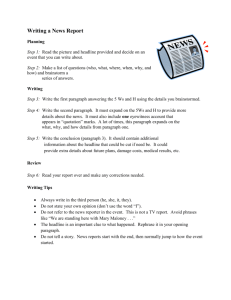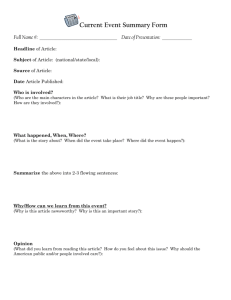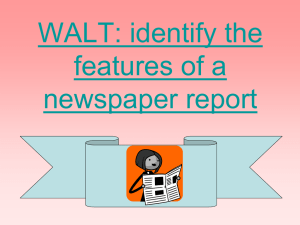News Report
advertisement
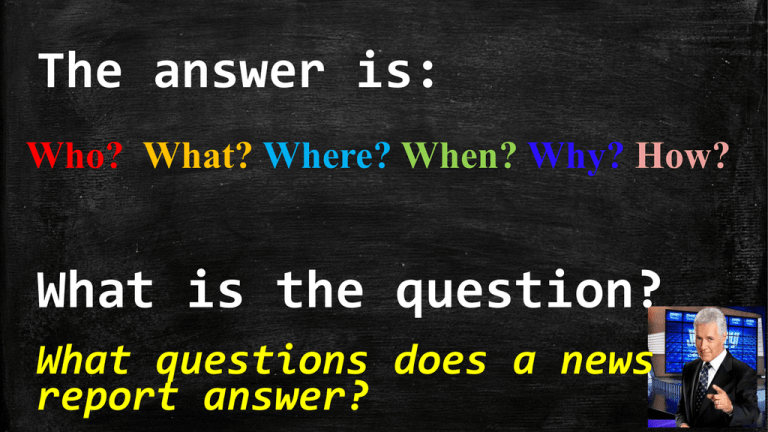
The answer is: Who? What? Where? When? Why? How? What is the question? What questions does a news report answer? Literacy Lessons 7 and 8 The OSSLT News Report Why do we need a lesson on writing a news report? ▪ The News Report is one of two long writing tasks ▪ It is marked out of 100 points; –60 points for “Topic Development” and –40 points for “Writing Conventions.” ▪ The number of points assigned to this task make it one of the most important tasks on the OSSLT. ▪ Do well on the News Report and you’re well on your way to passing the test. ▪ Do poorly on the news report and your chances of passing aren’t good. March 2015 News Report Results: 69% of JFSS students pass the task with a code 50 or code 60 Questions you might have about the news report that will be answered today What is a news report? What does the question look like? What, exactly, do I have to do? Why does EQAO make me write a news report? What are the key features of an OSSLT news report? Deconstruct one yourself to find out! Teachers: Handout the stapled package of materials Students: Read the news report “Students Achieve 100%” While reading, consider this question: If this is an exemplary news report, what are the key features of a news report? Features of an exemplary news report: • • • • • • 5Ws and H short sentences school related involves students written in 3rd person past tense • facts, not opinion • organized from most important to least important information • quotations What MUST be in your News Report 1. Four paragraphs (minimum): ▪ organized from most to least important information 2. Quotations ▪ minimum of two quotations by two different people 3. Conventions: ▪ third person, past tense, spelling, appropriate grammar, punctuation and sentence structure Parts of a News Report ▪Headline ▪Lead ▪Body Paragraph #1 ▪Body Paragraph #2 ▪(Body Paragraph #3) ▪Closing You will probably need this paragraph so you can put in the second quotation. What do I write in each part? The Headline ▪ EQAO gives you the headline ▪ The headline is the title above the picture ▪ It will include information about two or more of WHO, WHAT, WHERE, WHEN and WHY ▪ The headline is meant to catch your attention The Lead ▪ It is the first paragraph ▪ 1, maybe 2 sentences long ▪ It says what happened, when it happened, where it happened and who was involved. ▪ Begin with Yesterday, to keep the report in the past tense ▪ Invent everything using the photo and headline Body paragraph #1 ▪ Gives background information. It tells what led up to the event in the photo. ▪ Answers the questions: –Why did it/this happen? –How did it/this happen? –What was done about it/this? Body paragraph #2 ▪ Include an interview with someone who was directly involved; a bystander; an eyewitness ▪ Use direct quotes with quotation marks ▪ The quotation must give information about the event and make the reader feel like they are there ▪ Make up the speaker’s first and last name Body paragraph #3 ▪ This paragraph will involve a second interview with a different bystander, eyewitness… etc. ▪ Use direct quotes with quotation marks ▪ The quotation must give information about the event and make the reader feel like they are there ▪ Make up the speaker’s first and last name and use it Yes, it is the same as #2 but you provide different information about the event. Closing ▪ Close the report by stating what is expected to happen next or what might happen in the future. ▪ Keep it short and simple ▪ Do not restate what was said in the opening paragraph ▪ Body Paragraph #1: Answers the questions Why? and How? – Use Quotations that make the reader think they’re “at the scene” ▪ Body Paragraph #2: Explains the Who, What, When and Where? – Use Quotations that make the reader think they’re “at the scene” ▪ Closing: Concluding paragraph that answers:“What’s next?” – Do NOT restate information from the introductory paragraph – Keep it simple- approximately 1-2 sentences Key Points ▪ Lead: Introductory paragraph – Based on the headline and the photo. Begin this way: Yesterday________. – Must answer the questions: What, Where, When and Who? – Keep it simple- approximately 1-2 sentences All of this information is on page 3 and 4 of your handout 1) A Graphic organizer (p3) 2) A Checklist (p4) TIPS for writing news reports The Rules you must follow ▪ Lead answers: Who? What? Where? and When? in 1 or 2 sentences ▪ Body paragraphs fill in the important details and will be NO LONGER THAN 2-3 sentences each ▪ Third person (absolutely no personal language, except in quotes) ▪ Minimum of two quotes, either indirect or direct (word for word what somebody connected to the story said) More Rules you must follow ▪ Think of the event as just having happened we would then consistently use the past tense ▪ Focus on a single event and a single moment in time. It is not a story ▪ When referring to people, call them by their first and last name the first time, and by the last name thereafter….NEVER by the first name. ▪ Use the person’s title to add authority. For example, Mrs Nanavati, principal of John Fraser S.S. said…. Here’s a tip for you! News Report questions are often “school” related. If the headline refers to a school event, trip, contest or issue save yourself time and energy by using John Fraser Secondary School. Use your friends’ names and teachers you know and quote them to provide detail and “colour” in the report. Quote “Mrs. Nanavati” as the principal if you can. We think the most challenging part of the news report is that you have to “invent” everything: the situation, the people, the quotations etc. This is a lot of work and you don’t have much time. We have suggestions to help you be creative. First, take a really long look at the photo and the headline. There is a lot of information already there that you can expand on. You just have to take the time to look carefully. The Headline tells you what the story should be about. In this case it has to be a story about a Car wash which is a success. The key is to create a connection between the headline and the photo that you could use as an event for a report that would appear in a newspaper. What do you see? The Headline and the photo are equally important. Car wash a success The Photo gives you clues about Who the story is about and perhaps Why and How. What do you see? What happened before? Car wash a success What happens after? You are looking for connections between the headline and the picture. Car wash a success You get to make up everything. Your news report is framed by the 5Ws and H. Everything you invent comes from what they represent. Take a minute to review the 5Ws and H on the next slide. Keep the connections you made between the photo and headline in mind. –Who is the story about? –What happened? –Where did it happen? –Why did it happen and/or Why does it matter? –When did it happen? –And How did it happen? Go to the Rough Notes page (on test day). For now, use your own lined paper. 1) Write down the headline 2) Put an oval around the words in the headline. 3) Add the 5Ws and H around the oval. Who? How? What? Car wash a success When? Why? Where? Your rough notes page should look like this. (You are using your own lined paper today.) Car wash a success Car wash a success Next, look at the photo. (Go to page 2 in your handout). Divide the photo into quadrants and label everything you see in each quadrant. Car wash a success By dividing the picture into quadrants, you force your eyes to focus on every detail. You must focus on the people, the setting, and the event taking place in the photo. 1. Make up the facts using the photo. Car wash a success Look at each square one at a time. What do you see, notice or predict will happen given what you see in each square? These are your “facts”. Write them next to the appropriate 5 Ws in your rough notes. Record your facts NOW 2. Give names to the people in the photo and the location. 1. Make up first and last names for the people in the photo. Use your friend’s, and relative’s names 2. Give a name to the location in the photograph. Use your school’s name or other familiar locations in your neighbourhood. Write this in the rough notes area NOW 3.Make up facts related to the event. Make up some background information: – What happened before the photo was taken? – Add more information related to how and why the event took place 2. Make up quotes from witnesses or people involved Write this in the rough notes area NOW 4. Make up more information about the event. ▪ Invent information that is interesting to know but not so important. ▪ Compare this event to another event ▪ Suggest what might happen next Write this in the rough notes area NOW These steps are outlined on the “Rough Notes” sheet located on page 3 in your handout. Use this handout for future reference when you are writing OSSLT News Reports Ready to write a news report? Just before you start writing your report… You may want to use a graphic organizer to remind you of what goes where. This one is on page 3 in your handouts. The Lead: A suggestion ▪ Although there are no rules for what order you put the lead in, the following formula ALWAYS works: When + Where + Who + What = a one sentence Lead Why + How will go in the first body paragraph. Take a picture of this tip if you want it for future reference. When you finish: Be sure to review your work with the checklist on page 4 in your handout. Start Writing your news report. Use the “Car Wash a Success on page 2 in your handout package. It lets you judge how much space you will be allowed on test day You have 20 minutes to write your news report. Finished? Lets look at the exemplar on the next slide This is a Code 60 response. You have a copy along with other exemplars in your handout. View the slides and the handout if you wish. Who What When Where Why How This is an example of a good News Report Answer: You can see Who,What, When, Where, Why and How all right at the beginning of the report. This is a Code 60 It’s the best score you can get. Extra! Extra! They threw in a sub-head Real Newspaper stories (a second smaller headline usually have both of these that gives more detail) elements. It’s never a bad idea and a cutline to include them. (a caption that explains what’s in the photo). This report is clearly related to the headline and photo with a clear and consistent focus on an event. It’s got WHO, WHAT , WHERE, WHY and WHEN right up front. Then lots of detail on HOW backed up with quotations from different people involved. 1 This is good for a lot of reasons. It has lots of specific details (e.g., names of the city, students, a parent; Haiti, Canadian Red Cross, drivers couldn’t resist a good car cleaning, not only helped people in their community, but people hundreds of kilometres away). AND Quotations from two perspectives. The Organization easy to follow. The opening lead connects effectively to the closing sentence. 2 Evaluate your work using the “Topic Development” rubric on the next slide or the rubric on page 1 of your handout. The rubric in your handout is very small. A copy is posted on the OSSLT link on the JFSS website. How are the writing conventions for this task scored? Code 40: Writing Conventions Did all your questions get answered? Why does EQAO make me write a news report? End of Day 7 Surprisingly, in spite of the poor results, it is a task that brings students’ scores up. EQAO will continue to ask you to write the News Report on the OSSLT. Day 8: Practice, Practice, Practice Think Aloud News Report: Cawthra Park SS Click on the photo to watch the utube video Volunteers Help with Community Project ▪ Write the “Volunteers Help with Community Project” news report. – The photo and headline for this news report on page 4 of your handout. ▪ Use the graphic organizers on page 3 to guide what you write ▪ Review your work using the Checklist on page 4 Exchange your “Volunteers Help with Community Project” news report with a partner. Evaluate each other’s work using the rubric for topic development (next slide) The next slide contains the CPSS student’s news report that the teacher used in her video. Read the news report. (It is also on page 5 in your handout). Is it a code 60? Justify your decision. Another approach: Heart Lake Secondary School If you have time. Click on the screen to watch the Heart Lake S.S. Pow Toon vide0. Suggestions on next slide You have 20 minutes to write a news report. Suggestions: ▪ Use the graphic organizers and make rough notes. ▪ Review your work using the checklist on page 4 ▪ Exchange with your partner and evaluate each other’s work using the rubric (page 1) ▪ Read the code 60 exemplar for your news report on page 5 of the handout. You have 20 minutes to write a news report. More Practice…

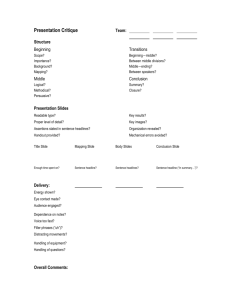
![[Type text] Fill in a fictional “headline from the future” above](http://s3.studylib.net/store/data/008674091_1-c12eeba0d4bd6938777e08ea064ad30a-300x300.png)
